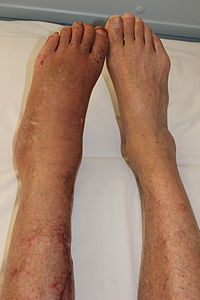
Photo from wikipedia
Complex regional pain syndrome (CRPS) has been considered to be an autoimmune disease and there have been clinical trials with intravenous immunoglobulin. Often the etiology of the so-called CRPS diagnosis… Click to show full abstract
Complex regional pain syndrome (CRPS) has been considered to be an autoimmune disease and there have been clinical trials with intravenous immunoglobulin. Often the etiology of the so-called CRPS diagnosis cannot be discerned and there are no validated instruments that provide functional metrics. The term complex regional pain syndrome (CRPS), coined in 1994 to describe patients in whom the pain is out of proportion to the injury, was actually a diagnosis proposed during the American Civil War, but was originally known as causalgia. Physicians have long observed similar sensitivity and inflammatory symptoms following periods of immobilization and disuse, which generally resolve within a few months of remobilization. Following the original description, persistent disproportionate pain would come to be known under many other names until researchers theorized that it was related to dysfunction in the sympathetic nervous system, after which it acquired the moniker, Reflex Sympathetic Dystrophy ("RSD"). In the latter quarter of the twentieth century, after researchers failed to prove the connection between the pain and the sympathetic nervous system, a small cadre of physicians-without rigorous science-invented CRPS. This new descriptor, CRPS, has become not only a diagnosis without objective data but with proposed criteria involving ambiguous signs and symptoms with low specificity. It has led to patients being treated erroneously with sympatholytic drugs, with or without pharmaceutical or surgical blockade of the sympathetic nervous system, unwarranted use of ketamine infusions, inappropriate use of narcotics and nerve stimulation. Intravenous immunoglobulin infusions have not been effective in the treatment of chronic pain. The indiscriminate use of pain medications to treat subjective symptoms of unclear diagnoses can be a risk factor for opioid and analgesic misuse or abuse.
Journal Title: Autoimmunity reviews
Year Published: 2019
Link to full text (if available)
Share on Social Media: Sign Up to like & get
recommendations!